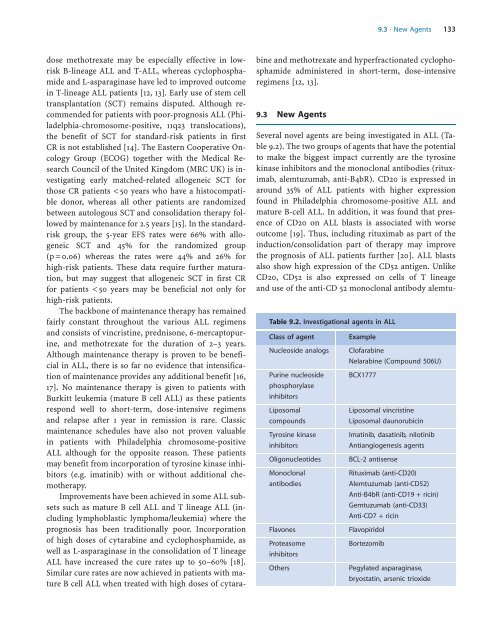Acute Leukemias - Republican Scientific Medical Library
Acute Leukemias - Republican Scientific Medical Library
Acute Leukemias - Republican Scientific Medical Library
Create successful ePaper yourself
Turn your PDF publications into a flip-book with our unique Google optimized e-Paper software.
a 9.3 · New Agents 133<br />
dose methotrexate may be especially effective in lowrisk<br />
B-lineage ALL and T-ALL, whereas cyclophosphamide<br />
and L-asparaginase have led to improved outcome<br />
in T-lineage ALL patients [12, 13]. Early use of stem cell<br />
transplantation (SCT) remains disputed. Although recommended<br />
for patients with poor-prognosis ALL (Philadelphia-chromosome-positive,<br />
11q23 translocations),<br />
the benefit of SCT for standard-risk patients in first<br />
CR is not established [14]. The Eastern Cooperative Oncology<br />
Group (ECOG) together with the <strong>Medical</strong> Research<br />
Council of the United Kingdom (MRC UK) is investigating<br />
early matched-related allogeneic SCT for<br />
those CR patients < 50 years who have a histocompatible<br />
donor, whereas all other patients are randomized<br />
between autologous SCT and consolidation therapy followed<br />
by maintenance for 2.5 years [15]. In the standardrisk<br />
group, the 5-year EFS rates were 66% with allogeneic<br />
SCT and 45% for the randomized group<br />
(p = 0.06) whereas the rates were 44% and 26% for<br />
high-risk patients. These data require further maturation,<br />
but may suggest that allogeneic SCT in first CR<br />
for patients < 50 years may be beneficial not only for<br />
high-risk patients.<br />
The backbone of maintenance therapy has remained<br />
fairly constant throughout the various ALL regimens<br />
and consists of vincristine, prednisone, 6-mercaptopurine,<br />
and methotrexate for the duration of 2–3 years.<br />
Although maintenance therapy is proven to be beneficial<br />
in ALL, there is so far no evidence that intensification<br />
of maintenance provides any additional benefit [16,<br />
17]. No maintenance therapy is given to patients with<br />
Burkitt leukemia (mature B cell ALL) as these patients<br />
respond well to short-term, dose-intensive regimens<br />
and relapse after 1 year in remission is rare. Classic<br />
maintenance schedules have also not proven valuable<br />
in patients with Philadelphia chromosome-positive<br />
ALL although for the opposite reason. These patients<br />
may benefit from incorporation of tyrosine kinase inhibitors<br />
(e.g. imatinib) with or without additional chemotherapy.<br />
Improvements have been achieved in some ALL subsets<br />
such as mature B cell ALL and T lineage ALL (including<br />
lymphoblastic lymphoma/leukemia) where the<br />
prognosis has been traditionally poor. Incorporation<br />
of high doses of cytarabine and cyclophosphamide, as<br />
well as L-asparaginase in the consolidation of T lineage<br />
ALL have increased the cure rates up to 50–60% [18].<br />
Similar cure rates are now achieved in patients with mature<br />
B cell ALL when treated with high doses of cytara-<br />
bine and methotrexate and hyperfractionated cyclophosphamide<br />
administered in short-term, dose-intensive<br />
regimens [12, 13].<br />
9.3 New Agents<br />
Several novel agents are being investigated in ALL (Table<br />
9.2). The two groups of agents that have the potential<br />
to make the biggest impact currently are the tyrosine<br />
kinase inhibitors and the monoclonal antibodies (rituximab,<br />
alemtuzumab, anti-B4bR). CD20 is expressed in<br />
around 35% of ALL patients with higher expression<br />
found in Philadelphia chromosome-positive ALL and<br />
mature B-cell ALL. In addition, it was found that presence<br />
of CD20 on ALL blasts is associated with worse<br />
outcome [19]. Thus, including rituximab as part of the<br />
induction/consolidation part of therapy may improve<br />
the prognosis of ALL patients further [20]. ALL blasts<br />
also show high expression of the CD52 antigen. Unlike<br />
CD20, CD52 is also expressed on cells of T lineage<br />
and use of the anti-CD 52 monoclonal antibody alemtu-<br />
Table 9.2. Investigational agents in ALL<br />
Class of agent Example<br />
Nucleoside analogs Clofarabine<br />
Nelarabine (Compound 506U)<br />
Purine nucleoside BCX1777<br />
phosphorylase<br />
inhibitors<br />
Liposomal<br />
compounds<br />
Tyrosine kinase<br />
inhibitors<br />
Liposomal vincristine<br />
Liposomal daunorubicin<br />
Imatinib, dasatinib, nilotinib<br />
Antiangiogenesis agents<br />
Oligonucleotides BCL-2 antisense<br />
Monoclonal<br />
Rituximab (anti-CD20)<br />
antibodies<br />
Alemtuzumab (anti-CD52)<br />
Anti-B4bR (anti-CD19 + ricin)<br />
Gemtuzumab (anti-CD33)<br />
Anti-CD7 + ricin<br />
Flavones Flavopiridol<br />
Proteasome<br />
inhibitors<br />
Bortezomib<br />
Others Pegylated asparaginase,<br />
bryostatin, arsenic trioxide
















